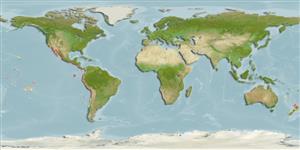>
Carangiformes (Jacks) >
Carangidae (Jacks and pompanos) > Trachinotinae
Etymology: Trachinotus: Greek, trachys, -eia, -ys = rough + Greek,noton = back (Ref. 45335).
More on author: Cuvier.
Environment: milieu / climate zone / depth range / distribution range
Ecologie
marien benthopelagisch; diepte 0 - 100 m (Ref. 122694). Subtropical; 35°N - 26°S, 121°W - 70°W
Eastern Pacific: Redondo Beach in southern California, USA to Chile, including the Galapagos Islands.
Grootte / Gewicht / Leeftijd
Maturity: Lm ? range ? - ? cm
Max length : 51.0 cm TL mannelijk / geslacht onbekend; (Ref. 2850); common length : 30.0 cm TL mannelijk / geslacht onbekend; (Ref. 55763)
Body deep (less so with age) and strongly compressed; mouth small; jaw teeth small, villiform, and only slightly hooked, disappearing with age; lower branch of first gill arch with 8 to 10 gill rakers; dorsal fin with 6 spines followed by another spine and 24 to 27 soft rays (VI+I, 24-27); upper third of body dark; belly white; flanks with golden highlights; no distinctive marks (Ref. 55763).
Adults are found in coastal waters, usually forming schools in shallow inshore sandy areas (Ref. 9283). They feed on mollusks, crustaceans, other invertebrates and small fishes (Ref. 9283). Excellent for human consumption. Minimum depth range based on estimate; to be replaced with a better reference.
Levenscyclus en paargedrag
Maturiteit | Voortplanting | Paaien | Eieren | Fecunditeit | Larven
Eschmeyer, W.N., E.S. Herald and H. Hammann, 1983. A field guide to Pacific coast fishes of North America. Boston (MA, USA): Houghton Mifflin Company. xii+336 p. (Ref. 2850)
Status op de Rode Lijst van het IUCN (Ref. 130435)
Gevaar voor de mens
Harmless
Gebruik door de mens
Visserij: van minder commercieel belang
Meer informatie
Lokale namenSynoniemenMetabolismePredatorenEcotoxicologieVoortplantingMaturiteitPaaienPaaiaggregatiesFecunditeitEierenOntwikkeling van de eieren
ReferentiesAquacultuurAquacultuurprofielKweeklijnenGeneticaElectrophoresesErfelijkheidZiektesVerwerkingNutrientsMassaconversie
Tools
Speciale rapporten
Download XML
Internetbronnen
Estimates based on models
Preferred temperature (Ref.
123201): 17.7 - 28.3, mean 23.2 °C (based on 70 cells).
Fylogenetische diversiteitsindex (Ref.
82804): PD
50 = 0.5000 [Uniqueness, from 0.5 = low to 2.0 = high].
Bayesian length-weight: a=0.00933 (0.00517 - 0.01686), b=2.90 (2.73 - 3.07), in cm total length, based on LWR estimates for this species & (Sub)family-body (Ref.
93245).
Trofisch niveau (Ref.
69278): 3.7 ±0.55 se; based on food items.
Weerstandsvermogen (Ref.
120179): Gemiddeld, minimale populatieverdubbelingstijd 1,4-4,4 jaar (Preliminary K or Fecundity.).
Fishing Vulnerability (Ref.
59153): Moderate vulnerability (40 of 100).
